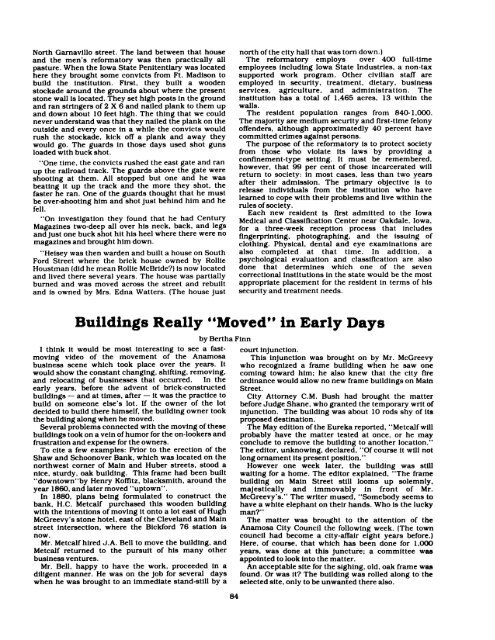Anamosa - A Reminiscence 1838 - 1988
The definitive history of the community of Anamosa, Iowa, USA
The definitive history of the community of Anamosa, Iowa, USA
Create successful ePaper yourself
Turn your PDF publications into a flip-book with our unique Google optimized e-Paper software.
North Garnaviilo street. The land between that house<br />
and the men's reformatory was then practically all<br />
pasture. When the Iowa State Penitentiary was located<br />
here they brought some convicts from Ft. Madison to<br />
build the institution. First, they built a wooden<br />
stockade around the grounds about where the present<br />
stone wall is located. They set high posts in the ground<br />
and ran stringers of 2 X 6 and nailed plank to them up<br />
and down about 10 feet high. The thing that we could<br />
never understand was that they nailed the plank on the<br />
outside and every once in a while the convicts would<br />
rush the stockade, kick off a plank and away they<br />
would go. The guards in those days used shot guns<br />
loaded with buck shot.<br />
"One time, the convicts rushed the east gate and ran<br />
up the railroad track. The guards above the gate were<br />
shooting at them. All stopped but one and he was<br />
beating it up the track and the more they shot, the<br />
faster he ran. One of the guards thought that he must<br />
be over-shooting him and shot just behind him and he<br />
fell.<br />
"On investigation they found that he had Century<br />
Magazines two-deep all over his neck, back, and legs<br />
and just one buck shot hit his heel where there were no<br />
magazines and brought him down.<br />
"Heisey was then warden and built a house on South<br />
Ford Street where the brick house owned by Rollie<br />
Houstman (did he mean Rollie McBride?) is now located<br />
and lived there several years. The house was partially<br />
burned and was moved across the street and rebuilt<br />
and is owned by Mrs. Edna Watters. (The house just<br />
north of the city hall that was torn down.)<br />
The reformatory employs over 400 full-time<br />
employees including Iowa State Industries. a non-tax<br />
supported work program. Other civilian staff are<br />
employed in security, treatment, dietary, business<br />
services, agriculture, and administration. The<br />
institution has a total of 1,465 acres, 13 within the<br />
walls.<br />
The resident population ranges from 840-1,000.<br />
The majority are medium security and first-time felony<br />
offenders, although approximatedly 40 percent have<br />
committed crimes against persons.<br />
The purpose of the reformatory is to protect society<br />
from those who violate its laws by providing a<br />
confinement-type setting. It must be remembered.<br />
however, that 99 per cent of those incarcerated will<br />
return to society: in most cases, less than two years<br />
after their admission. The primary objective is to<br />
release individuals from the institution who have<br />
learned to cope with their problems and live within the<br />
niles of society.<br />
Each new resident is first admitted to the Iowa<br />
Medical and Classification Center near Oakdale. Iowa,<br />
for a three-week reception process that includes<br />
fingerprinting. photographing, and the issuing of<br />
clothing. Physical, dental and eye examinations are<br />
also completed at that time. In addition, a<br />
psychological evaluation and classification are also<br />
done that determines which one of the seven<br />
correctional institutions in the state would be the most<br />
appropriate placement for the resident in terms of his<br />
security andltreatment needs.<br />
Buildings Really “Moved” in Early Days<br />
byBertha Finn<br />
I think it would be most interesting to see a fastmoving<br />
video of the movement of the <strong>Anamosa</strong><br />
business scene which took place over the years. It<br />
would show the constant changing, shifting, removing.<br />
and relocating of businesses that occurred. In the<br />
early years, before the advent of brick-constructed<br />
buildings — and at times, after — it was the practice to<br />
build on someone else's lot. If the owner of the lot<br />
decided to build there himself, the building owner took<br />
the building along when he moved.<br />
Several problems connected with the moving of these<br />
buildings took on a vein of humor for the on-lookers and<br />
frustration and expense for the owners.<br />
To cite a few examples: Prior to the erection of the<br />
Shaw and Schoonover Bank, which was located on the<br />
northwest corner of Main and Huber streets. stood a<br />
nice, sturdy, oak building. This frame had been built<br />
"downtown"by Henry Koffitz. blacksmith, around the<br />
year 1860, and later moved "uptown".<br />
In 1880, plans being formulated to construct the<br />
bank, H.C. Metcalf purchased this wooden building<br />
with the intentions of moving it onto a lot east of Hugh<br />
McGreevy's stone hotel, east of the Cleveland and Main<br />
street intersection, where the Bickford 76 station is<br />
now.<br />
Mr. Metcalf hired J .A. Bell to move the building, and<br />
Metcalf returned to the pursuit of his many other<br />
business ventures.<br />
Mr. Bell, happy to have the work, proceeded in a<br />
diligent manner. He was on the job for several days<br />
when he was brought to an immediate stand-still by a<br />
court injunction.<br />
This injunction was brought on by Mr. McGreevy<br />
who recognized a frame building when he saw one<br />
coming toward him; he also knew that the city fire<br />
ordinance would allow no new frame buildings on Main<br />
Street.<br />
City Attorney C.M. Bush had brought the matter<br />
before Judge Shane, who granted the temporary writ of<br />
injunction. The building was about 10 rods shy of its<br />
proposed destination.<br />
The May edition of the Eureka reported. “Metcalf will<br />
probably have the matter tested at once, or he may<br />
conclude to remove the building to another location."<br />
The editor, unknowing, declared, "Of course it will not<br />
long ornament its present position."<br />
However one week later. the building was still<br />
waiting for a home. The editor explained, "The frame<br />
building on Main Street still looms up solemnly,<br />
majestically and immovably in front of Mr.<br />
McGreevy's." The writer mused, "Somebody seems to<br />
have a white elephant on their hands. Who is the lucky<br />
man?"<br />
The matter was brought to the attention of the<br />
<strong>Anamosa</strong> City Council the following week. (The town<br />
council had become a city-affair eight years before.)<br />
Here, of course. that which has been done for 1,000<br />
years. was done at this juncture: a committee was<br />
appointed to look into the matter.<br />
An acceptable site for the sighing, old, oak frame was<br />
found. Or was it? The building was rolled along to the<br />
selected site. only to be unwanted there also.



